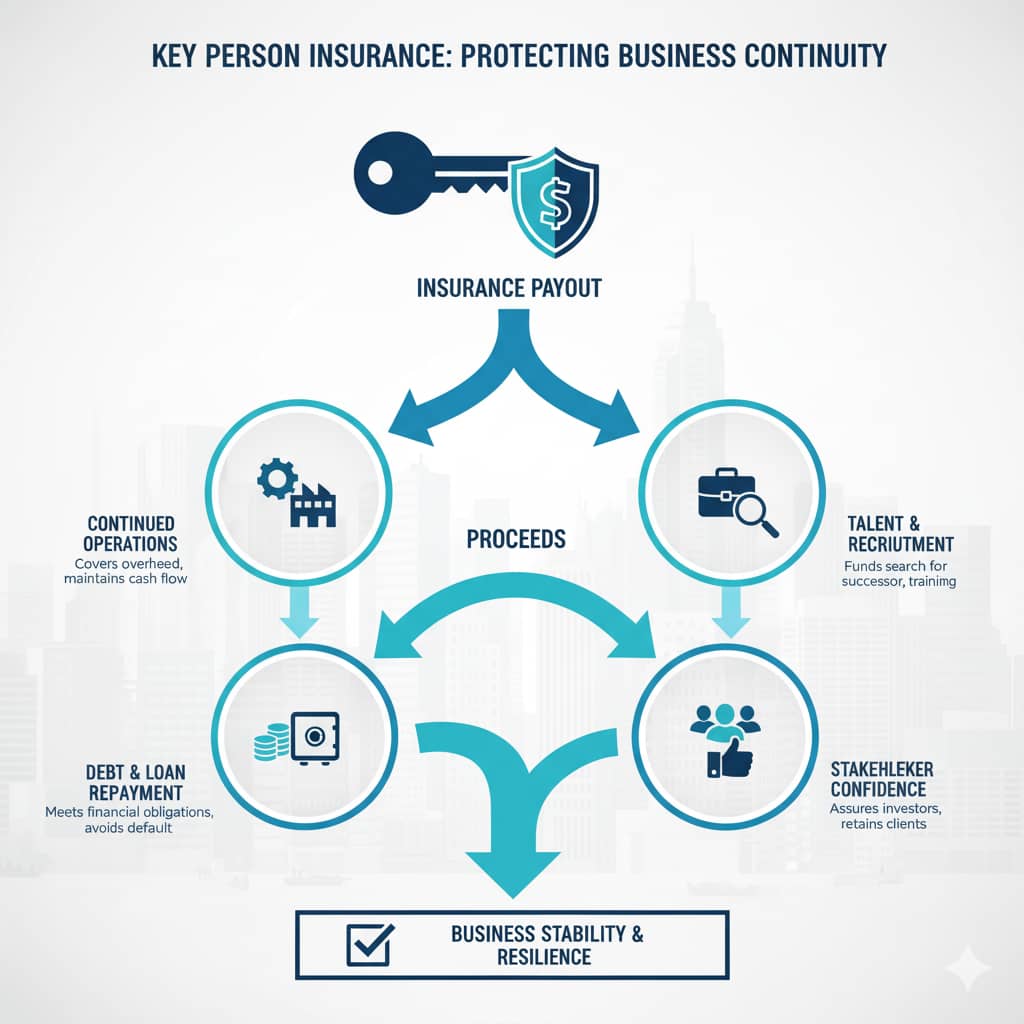Key person insurance safeguards your business against the devastating financial impact of losing crucial team members. Discover how to identify key persons, calculate coverage needs, and structure policies for maximum protection. The email arrived on a Tuesday morning, our chief technology officer had been in a serious car accident. While we were relieved he would recover, the reality hit hard: our product roadmap stalled, investor meetings canceled, and critical systems began showing cracks only he understood. The six months it took him to return to full capacity cost us nearly $500,000 in delayed launches and missed opportunities. That experience taught us what many businesses learn too late: some employees are so valuable that their absence threatens the organization itself. This realization led us to implement key person insurance, a strategic use of life insurance that protects businesses from the financial consequences of losing indispensable team members.
Key person insurance is essentially life insurance purchased by a business on a crucial employee, with the company as beneficiary. While the concept sounds straightforward, its implementation requires careful planning to ensure adequate coverage and proper structure. The first challenge lies in identifying who truly qualifies as a “key person.” These aren’t necessarily the highest-paid executives but rather individuals whose knowledge, skills, or relationships are irreplaceable in the short term. In our case, it was our CTO, but for other businesses, it might be the sales director who maintains all client relationships, the founder with unique industry connections, or the production manager who alone understands specialized equipment.
The coverage amount calculation requires both art and science. A common approach involves estimating the financial impact across several dimensions: replacement costs (recruitment fees, training expenses, signing bonuses), lost revenue during the transition period, and potential business interruption costs. For revenue-generating key persons, many insurers recommend coverage equal to 5-10 times their annual compensation. We calculated our CTO’s value by projecting revenue delays from product setbacks and adding the estimated cost of hiring and onboarding a replacement, arriving at a $2 million policy that seemed substantial until we realized it represented just nine months of his true impact.
Policy ownership and beneficiary designations require particular attention. The business typically applies for, owns, and pays premiums on the policy, then names itself as beneficiary. This structure ensures the company receives the death benefit tax-free, providing liquidity during a crisis. However, businesses must have an insurable interest in the key person, meaning the company would suffer financially from their loss. This requirement generally poses no problem for crucial employees but can become complicated with minority shareholders or contract workers.
The type of life insurance matters significantly. Term life insurance often works well for key person coverage because it provides substantial death benefits at affordable premiums for a set period, usually 10, 20, or 30 years. This aligns with most businesses’ need for protection during a key person’s peak contribution years. Permanent life insurance might be preferable when the need extends beyond typical term lengths, or when the company wants to build cash value that can be borrowed against later. We chose a 20-year term policy that would protect us until our CTO’s planned retirement while keeping premiums manageable for our growing business.

The application process involves unique considerations. The key person must consent to the coverage and participate in medical underwriting. This conversation requires sensitivity, framing the insurance as recognition of their value rather than morbidity. We presented it to our CTO as: “You’re so important to our success that we need to protect the business in case anything prevents you from contributing.” This approach helped him feel valued rather than uncomfortable.
Premium payments and tax treatment create important financial considerations. Businesses generally cannot deduct key person insurance premiums as business expenses. However, death benefits typically arrive income-tax-free, providing crucial liquidity when needed most. The accounting treatment varies too—while the death benefit isn’t taxable income, the premiums don’t create tax advantages. This makes key person insurance a pure risk management tool rather than a tax strategy.
Beyond death benefits, many key person policies include living benefits that address disability or critical illness. These riders can provide funds if a key person becomes disabled but doesn’t die, covering costs like hiring temporary replacements or funding buy-sell agreements triggered by disability. We added a disability rider that would have provided monthly payments during our CTO’s recovery, coverage we wish we’d had during his actual absence.
The strategic implications extend beyond immediate financial protection. Having key person insurance can reassure investors, lenders, and business partners that the company has contingency plans for crucial personnel risks. This demonstration of risk management sophistication often strengthens the company’s position in negotiations and valuations. When we sought additional funding, several investors specifically noted our key person coverage as evidence of mature leadership.
Policy proceeds usage should be planned in advance rather than decided during a crisis. Common applications include recruiting and training replacements, paying off debts if the business must scale back, distributing bonuses to retain remaining staff, or funding buy-sell agreements if the key person was also an owner. We documented that our policy proceeds would first cover operational costs for six months while we recruited a replacement, then fund a signing bonus for the right candidate.
Regular review ensures coverage remains adequate as businesses evolve. Key persons change as companies grow—what begins as founder-focused coverage might need to expand to include other crucial team members. We now review our key person insurance annually, assessing whether new hires or promotions create additional key persons requiring protection. This proactive approach prevents coverage gaps as the business transforms.
The true value of key person insurance emerges not when claims are paid, but when businesses continue operating smoothly despite devastating losses. It represents the ultimate acknowledgment that people, not just products or patents, drive business success. By protecting against the financial impact of losing irreplaceable talent, key person insurance provides stability that allows businesses to take calculated risks, invest in growth, and build lasting value.
References
Augusta Financial. (2025, March 25). Key person life insurance. https://augustarfinancial.com/key-person-life-insurance/
Thrivent Financial. (2025, July 21). How key person life insurance can help protect your business. https://www.thrivent.com/insights/life-insurance/how-key-person-life-insurance-can-help-protect-your-business
Engage Health Group. (2023, July 25). Protecting your business with key person life insurance. https://www.simcoservices.com/protecting-your-business-with-key-person-life-insurance
Insurance Information Institute. (2017, September 5). Life insurance for key employees. https://www.iii.org/publications/insuring-your-business-small-business-owners-guide-to-insurance/specific-coverages/life-insurance-for-key-employees
Investopedia. (2023, May 1). Key person insurance: Definition, cost, types, and how it works. https://www.investopedia.com/terms/k/keypersoninsurance.asp

